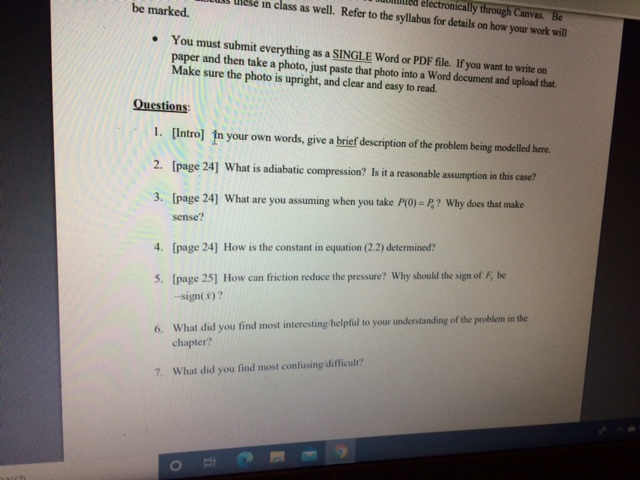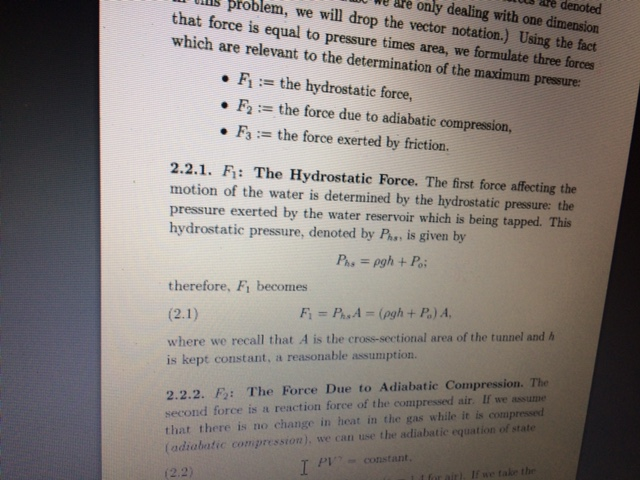qs 1 plz


electronically through Canvas. Be in class as well. Refer to the syllabus for details on how your work will be marked. . You must submit everything as a SINGLE Word or PDF file. If you want to write on paper and then take a photo, just paste that photo into a Word document and upload that. Make sure the photo is upright, and clear and easy to read. Questions 1. [Intro] fn your own words, give a brief description of the problem being modelled here. 2. (page 24] What is adiabatic compression? Is it a reasonable assumption in this case? 3. (page 24] What are you assuming when you take P(O)=P? Why does that make sense? 4. (page 24] How is the constant in equation (2.2) determined? 5. (page 25] How can friction reduce the pressure? Why should the sign of be -sign(x)? 6. What did you find most interesting helpful to your understanding of the problem in the chapter? 7. What did you find most confusing difficult? o arch denoted are only dealing with one dimension oblem, we will drop the vector notation.) Using the fact that force is equal to pressure times area, we formulate three forces which are relevant to the determination of the maximum pressure: Fi := the hydrostatic force, F2 := the force due to adiabatic compression, F3 := the force exerted by friction. 2.2.1. F1: The Hydrostatic Force. The first force affecting the motion of the water is determined by the hydrostatic pressure: the pressure exerted by the water reservoir which is being tapped. This hydrostatic pressure, denoted by P., is given by P. = pgh + P.; therefore, F becomes (2.1) Fi = PA = (ogh + P.) A, where we recall that A is the cross-sectional area of the tunnel and h is kept constant, a reasonable assumption. 2.2.2. F: The Force Due to Adiabatie Compression. The second force is a reaction force of the compressed air. If we assume that there is no change in heat in the gas while it is compressed (adiabatic compression), we can use the adiabatic equation of state (2.2) I PU for we fake the electronically through Canvas. Be in class as well. Refer to the syllabus for details on how your work will be marked. . You must submit everything as a SINGLE Word or PDF file. If you want to write on paper and then take a photo, just paste that photo into a Word document and upload that. Make sure the photo is upright, and clear and easy to read. Questions 1. [Intro] fn your own words, give a brief description of the problem being modelled here. 2. (page 24] What is adiabatic compression? Is it a reasonable assumption in this case? 3. (page 24] What are you assuming when you take P(O)=P? Why does that make sense? 4. (page 24] How is the constant in equation (2.2) determined? 5. (page 25] How can friction reduce the pressure? Why should the sign of be -sign(x)? 6. What did you find most interesting helpful to your understanding of the problem in the chapter? 7. What did you find most confusing difficult? o arch denoted are only dealing with one dimension oblem, we will drop the vector notation.) Using the fact that force is equal to pressure times area, we formulate three forces which are relevant to the determination of the maximum pressure: Fi := the hydrostatic force, F2 := the force due to adiabatic compression, F3 := the force exerted by friction. 2.2.1. F1: The Hydrostatic Force. The first force affecting the motion of the water is determined by the hydrostatic pressure: the pressure exerted by the water reservoir which is being tapped. This hydrostatic pressure, denoted by P., is given by P. = pgh + P.; therefore, F becomes (2.1) Fi = PA = (ogh + P.) A, where we recall that A is the cross-sectional area of the tunnel and h is kept constant, a reasonable assumption. 2.2.2. F: The Force Due to Adiabatie Compression. The second force is a reaction force of the compressed air. If we assume that there is no change in heat in the gas while it is compressed (adiabatic compression), we can use the adiabatic equation of state (2.2) I PU for we fake the








